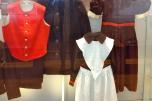In the early 18th century, London was home to the very rich and the very poor. Many mothers could not afford to care for their children - 1,000 babies were abandoned throughout London every year. Last week on a trip to London I visited the Foundling Museum, once the headquarters of the Foundling Hospital on Brunswick Square (not far from the British Museum).
The British shipbuilder Thomas Coram left for America in 1693. When he returned to London with his wife Eunice, a Bostonian, in 1719 he was appalled by the number of abandoned babies - and he became determined to set up a home for them. He needed financial backing - it was a quest that took 20 years. Coram convinced Queen Caroline (the wife of King George II) to support the cause and, in 1741, the Foundling Hospital was established. William Hogarth and George Frideric Handel both became patrons. (Paintings by Hogarth and a copy of the Messiah are on display.)
In the beginning children were admitted on a first come, first served basis. But, after one year, the hospital could not provide homes to every child. A new lottery system (using multi-colored balls) was put in place. Each mother would pick a ball from a sack. If she picked a black ball, her baby would not be accepted. With a white ball the baby would be admitted provided the child passed the medical exam and had no diseases. A red ball meant the child would be placed on a waiting list -- accepted only if another child failed the medical test. 1500 children were admitted under the lottery system between 1742 and 1756. Later children were admitted based on petitions as well as a lottery system. And, in some cases, children were admitted with a donation of 100 pounds. The hospital became home to 18,500 children by the end of the century.
On display are several of the uniforms the children wore, as well as "tokens" - small items the mothers left with their children, - a means to identify the child, a gift, and a symbol of love. These are small pieces of paper with a note or a poem, a medal, a coin, a thimble, a ring or locket, a small embroidered piece of fabric. In some cases a mother would leave half of something (such as a playing card) or part of a pair (perhaps a dress sleeve). The thimble in the photograph belonged to an Irish boy named Joseph (and renamed John Johnson). Each token was kept folded inside a billet (or information sheet). Most children never saw their tokens and never learned their identities - the billets were only opened on the rare occasions when a child was claimed.
There are no children living here today but the Foundling Museum does provide educational and art outreach programs for children.

